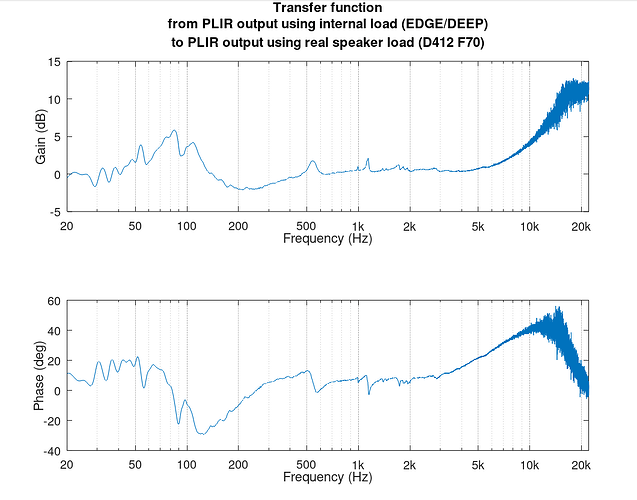I had the inspired idea of trying to capture the transfer function from the PLIR output when using the internal load to the same output when using the cab-thru, hooked up to my Deliverance 412 F70.
Here’s what I did:
- Recorded a DI guitar signal into my DAW
- Routed the DI track in my DAW to an analog output
- Connected the analog output to my pedal board hooked up to my amp (here is where I would use a DI box if I had one in order to get the isolation etc. But it worked okay regardless).
- Connected the amp to my PLIR, and hooked up the cab-thru to my speaker cab
- Turned the amp on and adjusted the MV (relatively low volume), and adjusted the analog output DI signal volume
- Recorded the PLIR output signal when playing back the DI signal from my DAW.
- Turned the amp off, disconnected the cab-thru, set the reactive load switches to EDGE/DEEP
- Turned the amp on, recorded the PLIR output signal when playing back the DI signal from my DAW
This gives me two signals: the first is the “output” I want, and the second is the “input”. I ran a short segment (5 seconds worth) of those two through my deconvolution script I hinted at above to get the transfer function.
Here’s the frequency response of said transfer function:
Interpretation: when using the cab-thru vs the internal load, there is an overall slight increase in volume, a pronounced high frequency boost above 3 kHz, a sharp boost of 5 or 6 dB at 80 Hz, and a broad attenuation around 250 Hz. Plus some other minor things.
Performance: I took the IR I generated from this experiment and applied it to the full recording I obtained from the PLIR using the internal load. This basically passed a null-test with the signal using the cab-thru. The error-to-signal ratio of the null-test was like -34 dB.
What is the significance of this? I have showed that I can duplicate a cab-thru recording environment completely silently.
What can I do next?
- I can chain this with the speaker/mic IR generation I hinted at previously to create a full speaker/mic silent emulation using the PLIR which I think should pass a null-test (at low volume). I’m not aware of this being demonstrated by anyone else.
- I accidentally created these transfer functions using the analog cab output from the PLIR instead of the raw output. The result I believe is the extra noisiness in the transfer function at high frequencies. I’ll re-create this experiment with the analog cab sim turned off.
- Recreate the experiment with different reactive load switch settings
- Recreate the experiment for different amplifiers. Different amplifiers have different source impedances and will react to load impedance changes in different ways. This experiment was done with my Deliverance 60 (gen 1)
- I keep hinting at “low volume.” As we know, a tube amp (or any real amp) will have a non-linear relationship with its load as the power output increases. At low volumes the relationship is linear hence we can describe its transfer function in linear terms. I do not expect that the transfer function I modeled here will hold up at high volumes (the null test would not pass). The only way to silently emulate the cab-thru scenario at moderately-loud volumes (where the tubes/output tranny are non-linear but the loudspeakers themselves are not saturated) would be to construct a physical reactive load which models the physical speakers’ impedance, in situ. I have an experiment in mind where I can measure the loudspeakers impedance in situ while playing. More to come.
Edit: addendum:
I tried applying the transfer function above to some recordings I had made with the PLIR at moderate/loud MV settings on my amp and, while I wouldn’t expect them to pass a hypothetical null test vs recording with cab-thru, they still sound much more “alive” and realistic than without. So that’s a major win! And gives credence to the use case of “use the PLIR internal load to give you the gross reactance/dynamics and then get that last bit using digital means.” You could even take the IR generated from these means, and compose it into an existing speaker/mic IR which you then load into the PLIR itself.
I was additionally curious about those minor spikes in the transfer function a little above 500 Hz and 1 kHz. Obviously some kind of resonance in the loudspeaker/cabinet. So I went and looked at the F70 datasheet… lo and behold, you can see some spiking in the impedance at conspicuously close frequencies. https://www.fane-acoustics.com/view-product/Ascension-F70
Shifts in the resonances can be ascribed to either the “G” differences Steve sometimes talks about, or maybe the enclosure itself.
